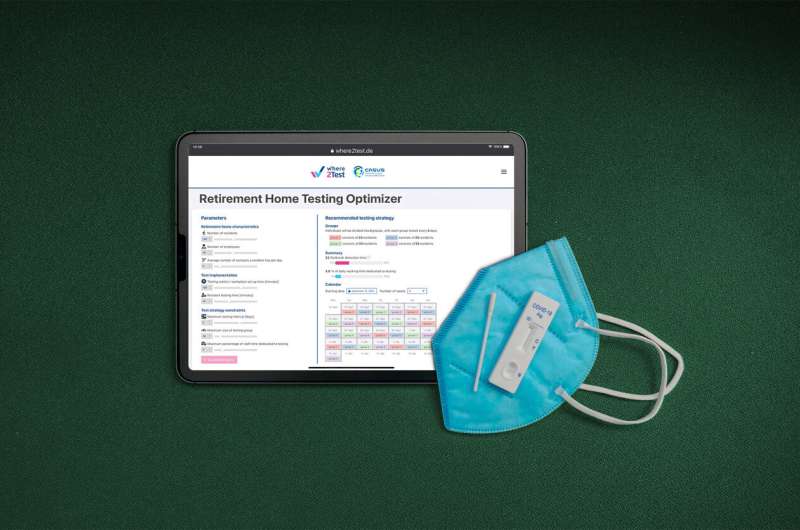
The Where2Test team’s third web application provides retirement and nursing homes with a scientific basis for devising a testing strategy in times of pandemic. Taking various factors into account, the app suggests daily testing of individual groups of residents at set intervals of two to several days.
The recommended strategy aims to detect a disease outbreak in the shortest time possible without overwhelming nursing staff with testing duties. The coronavirus pandemic has shown that day-to-day patient care can suffer as a result of demanding testing efforts. The application was developed by the Where2Test team at the Center for Advanced Systems Understanding (CASUS) at the Helmholtz-Zentrum Dresden-Rossendorf (HZDR). In the process, the group drew on the expertise of care facility managers. The app is available online.
The so-called Retirement Home Testing Optimizer was developed based on collected data and direct exchange with long-term care facilities (LCF) operated by the Diakonie Löbau-Zittau. According to Managing Director Dr. Birgit Wagner, there is now a much better understanding of the complex interrelationships behind devising a testing strategy: “One hopes that science will provide an immediate solution to all problems. But as is often the case, the devil is in the details. My association with the CASUS team has taught me that true science approaches each problem one piece at a time. I’m very happy with this app, as it will help us find an efficient testing strategy should the Corona Protection Regulations prospectively allow more flexibility for testing, or if the testing obligation is lifted completely.”
Two contradictory goals
Rapid detection of infections is only possible through a substantial testing effort and, thus, an additional workload. Conversely, keeping the workload as low as possible by retaining the testing efforts at a minimum leads to very late outbreak detection. The new Where2Test web application resolves this conflict in a situation-specific manner. This implies that the respective preferences and circumstances of the facility are decisive factors when setting up the testing strategy.
The app incorporates customizable parameters such as facility size, number of resident contacts, time and effort required to set up the testing station, and duration of individual testing. Other relevant parameters are assumed to be fulfilled, including full vaccination of all residents and a transmission rate consistent with the SARS-CoV-2 Omicron variant. However, several other factors necessary to create an optimal testing strategy cannot be taken into account by the app. These include, for example, individual residents’ risk of becoming infected and transmitting the virus, which depends, in part, on their age and comorbidities.
After entering the various key parameters, the app recommends a testing strategy based on organizing all residents into two or more groups. A calendar then shows on which day a particular group should be tested. For each calculated testing strategy, the app also indicates the average number of hours it takes to detect an infection introduced into the facility and the proportion of the staff’s daily working time spent on testing.
“Our new app can greatly benefit LCF management with regard to balancing infection risk against care quality according to the facility’s specific circumstances,” reckons Prof. Justin Calabrese, head of the Where2Test project.
“In this deliberation, of course, external circumstances play a major role, including, for example, the frequency of SARS-CoV-2 infections in the region. We advise reviewing the established testing strategy for a particular facility regularly and adjusting it depending on the situation. This holds especially true with an eye toward this fall when experts predict infection numbers to rise.”
Space with multiple comparable solutions sought
The web application uses a novel model developed by the Where2Test team to optimize testing schedules in LCF. Because the model pursues the optimization of two conflicting objectives—the shortest possible time to detect an infection with the least possible testing effort—it is called a bi-objective optimization model.
Source: Read Full Article





